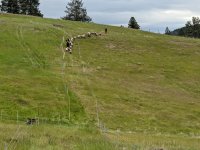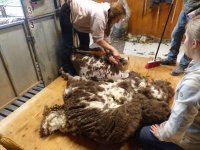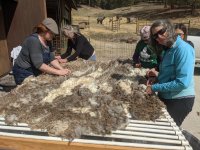John Steitz
New member
We raise colored merino sheep specifically for the fiber artist. Our flock is very small, maximizing at 25 breeding adults. This combination of specialty and small has really worked out for us. Yes, small operations can succeed but you need to manage like a small flock, not a large flock. I have also raised commercial wool sheep and completely failed in a different situation. Failure is an important teacher and 30 years away gave me a chance to re think how to manage things both different and better. There are ways that we manage our small specialty flock that simply would not work for a large commercial flock. Our targets are different so of course we do things a bit different.
Pick a breed that you can match a market to. Or possibly you pick your breed by the market you want to target. We may or may not raise sheep to make money but they are an expense and it is advisable that you find a way to have some income to pay those expenses before you begin. Even a hobby needs to have a budget or you won’t be doing it long. Once you make that choice strive to manage the best for your animals and that market goal. You are never done learning. Markets change, grow with it.
Partnering is very important for small wool flocks. The challenge I hear most often is “I can’t find a shearer?” What we did to overcome that challenge is to partner with 3-4 other small wool flocks and it has grown to 10-15 small wool flocks of different breeds and crosses over 10 years in the Flathead Valley where we are located. We schedule a shearer for a week. Someone always has an extra room or apartment so that takes care of housing. We each contract with the shearer individually and shear at our own place. Yes we do lend a hand from one flock to another where needed. This is a win for us and a win for the shearer.
I need to roll back one moment. For this to happen you need a sheep calendar. When do you want lambs? Shearing should be a minimum of 21 days before first lambs. We all agreed on May and we shear first week of April. That seems to be the best balance for us in NW Montana. Yours may be different. It is the overall calendar that matters. Now that you know lambing and shearing dates you know ram in date is 150 days prior. Ram in day is also the late date for scheduling the shearer. You can schedule earlier but after that date you lose some control of your calendar to make adjustments.
These same partners can also be very important to share bulk feed pricing, breeding services, shareable equipment, vaccines, wormers and more. When I have a customer wanting to buy a breeder ram and ewe and I only have a ram to sell, I call one of my partners and we can sell as a “package”. One from me at my selling price and one from my partner at their price. I have a better chance to sell that ram if I am partnering with others.
We do all of our wool sales as individual sales as different products. Each of my partners is different in how we market and sell our wool to meet our tastes. That is important to say that there is plenty of room to move here. You do not have to copy anyone. Be yourself how you want to do it. We know our partner’s products or need to sell and no question we refer customers to each other? It works very well. We are strength in numbers and cooperation but each is as independent as we want to be.



Pick a breed that you can match a market to. Or possibly you pick your breed by the market you want to target. We may or may not raise sheep to make money but they are an expense and it is advisable that you find a way to have some income to pay those expenses before you begin. Even a hobby needs to have a budget or you won’t be doing it long. Once you make that choice strive to manage the best for your animals and that market goal. You are never done learning. Markets change, grow with it.
Partnering is very important for small wool flocks. The challenge I hear most often is “I can’t find a shearer?” What we did to overcome that challenge is to partner with 3-4 other small wool flocks and it has grown to 10-15 small wool flocks of different breeds and crosses over 10 years in the Flathead Valley where we are located. We schedule a shearer for a week. Someone always has an extra room or apartment so that takes care of housing. We each contract with the shearer individually and shear at our own place. Yes we do lend a hand from one flock to another where needed. This is a win for us and a win for the shearer.
I need to roll back one moment. For this to happen you need a sheep calendar. When do you want lambs? Shearing should be a minimum of 21 days before first lambs. We all agreed on May and we shear first week of April. That seems to be the best balance for us in NW Montana. Yours may be different. It is the overall calendar that matters. Now that you know lambing and shearing dates you know ram in date is 150 days prior. Ram in day is also the late date for scheduling the shearer. You can schedule earlier but after that date you lose some control of your calendar to make adjustments.
These same partners can also be very important to share bulk feed pricing, breeding services, shareable equipment, vaccines, wormers and more. When I have a customer wanting to buy a breeder ram and ewe and I only have a ram to sell, I call one of my partners and we can sell as a “package”. One from me at my selling price and one from my partner at their price. I have a better chance to sell that ram if I am partnering with others.
We do all of our wool sales as individual sales as different products. Each of my partners is different in how we market and sell our wool to meet our tastes. That is important to say that there is plenty of room to move here. You do not have to copy anyone. Be yourself how you want to do it. We know our partner’s products or need to sell and no question we refer customers to each other? It works very well. We are strength in numbers and cooperation but each is as independent as we want to be.








